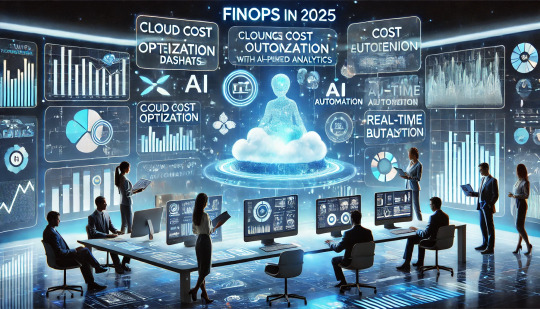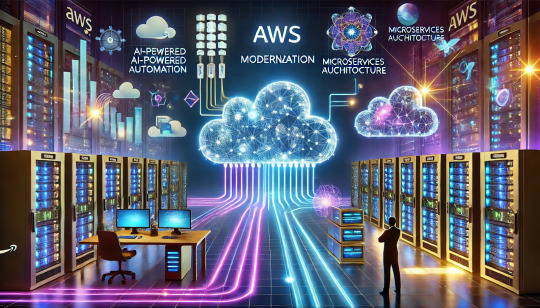Don't wanna be here? Send us removal request.
Text
What is the Trend in FinOps 2025?

Financial Operations or FinOps has developed with amazing speed to keep pace with the intricacies of modern cloud environments and changing technologies. Now, in 2025, FinOps has transcended the borders of cost reduction and essentially means the creation of business value, innovation, and financial transparency. Organizations are tuning their cloud approach to effectively harness infrastructure, performance, and efficiency across the board. Here are the most relevant FinOps trends defining 2025.
Cost Optimization to Innovation
While cost optimization remains key, organizations now leverage FinOps to promote innovation and efficiency in operations. Technology-driven FinOps is now the core of business – using data-driven decision-making and cloud automation to achieve cost optimization without violating any growth principles. To achieve this, there must be strong collaboration between IT, finance, and operations teams.
Cloud Governance Strengthening
The majority of organizations struggle with diverse cloud infrastructures and disparate governance. In 2025, organizations are applying more robust cloud governance structures to enhance financial accountability. Some of the main initiatives are:
Resources will be tagged for better tracking of costs.
Centralized FinOps teams to ensure compliance with budgeting policies.
Real-time tracking of cloud expenses to eliminate inefficiencies.
AI and Predictive Analytics Integration
By deploying AI and predictive analytics, FinOps is drastically changing:
Automated cost optimization based on real-time insight.
Cloud costs forecasting to avert overspend.
Savings between multi-clouds.
By 2025, most AI-based FinOps solutions would be adopted widely for prescriptive decision-making on cloud cost control.
Customized, Industry-Wise FinOps Approaches
Every industry has its unique challenges for cloud cost control and this leads to industry-wide FinOps approaches:
Healthcare is all about compliance, data security, and tiered storage.
Retail is about predictive analytics to scale cloud resources in peak seasons.
Financial services intend to invest in next-gen cost visibility solutions like CloudZero and Finout.io.
Emergence of Managed FinOps Services
With increasing complexity of FinOps, many organizations turn to specialized FinOps service providers for cloud cost management. Thus, the services can help firms to:
20-30% savings on operating costs.
Use specialized FinOps talent without building internal teams.
Use full automation in cloud expense tracking and control.
Expanding Beyond Public Cloud: The Cloud+ Approach
FinOps is expanding beyond the management of public clouds and now includes:
Optimization of SaaS cost.
Control of private cloud expenditures.
Management of financials for on-premise infrastructure.
In this way, we can achieve end-to-end financial management for all IT investments in a Cloud+ approach.
AI Spending Management
With wider AI adoption, FinOps teams are increasingly focusing on the governance of cost related to AI. In 2025, 63 percent of organizations monitor AI.
Conclusion
FinOps is projected to transition from a cost management program into a strategic partner for finance organizations with respect to innovation, efficiency, and accountability in the year 2025 and beyond. These organizations are driving AI-based analytics, automation, and real-time visibility into financial information to enable agility and scalability in a cloud environment. The game-changers behind the transformation of organizations in managing their investments into the cloud will be managed services through FinOps, The Cloud+, and sustainability initiatives.
FinOps is not just about saving money anymore but optimizing the value of a business by integrating it into financial operations with organizational objectives. AI-embedded cost management, industry-specific FinOps, and real-time dashboards will provide companies with an edge in their race for operational efficiency. The evolution of cloud technologies will increasingly embed FinOps into financial strategies for making organizations cost-efficient, operationally efficient, and future-ready.
0 notes
Text
AWS Modernization: Ambitiously Rejuvenating the Cloud Journey with Innovation

Firms are all rushing towards the cloud-basted solution due to massive demand for agility, cost-effectiveness, and innovation within this fast-paced digital epoch. AWS offers innovation solutions to modernize legacy architecture, optimize workloads and achieve operational excellence. This blog analyzes the features of some top AWS modernization services, showing how they can change the course of your cloud journey.
1. AWS Lambda
AWS Lambda is a serverless computing service that runs code without having to provision or manage servers. It scales automatically according to demand, so you can build scalable applications and reduce the infrastructure complexity.
2. Amazon ECS and EKS
Modernization of application deployment is now easier with Amazon ECS and EKS. This allows organizations to move towards containerization, has simplified application management, and assures scalability across environments.
3. AWS Fargate
AWS Fargate is a serverless compute engine for containers that eliminated the need for server management; therefore, the developers can focus on just developing apps. This not only optimizes resource use due to pay-as-you-go pricing and automatic scaling.
4. Amazon Aurora
Amazon Aurora is an extremely high-performing, resilient cloud-native relational database service that is compatible with open-source engines MySQL and PostgreSQL, making the tool ideal for any organization looking to migrate databases.
5. AWS Application Migration Service
The AWS Application Migration Service (AWS MGN) makes it easier to move applications from on-premises to AWS. It automates significant parts of the migration process and minimizes downtime.
6. AWS DevOps Tools
AWS has matured in terms of using numerous development tools, from AWS CodePipeline, AWS CodeBuild, and AWS CodeDeploy, that allow for continuous integration and continuous delivery (CI/CD), thus minimizing changes to development cycle times and effectiveness of deployment.
7. AWS Modernization Hub
The AWS Modernization Hub is a one-stop solution for the planning and execution of modernization projects. It provides insights, resources, and guidance toward fine-tuning modern architecture migration.
Utilization of AWS modernization solutions keeps organizations at the forefront, innovating ahead of time and optimizing business processes. With serverless computing, containerization, and automated migrations, AWS is the secret to your future-proof cloud. Using these very available solutions, organizations can create new avenues for growth and digital transform.
Conclusion
AWS modernization is a wholesale cleanup and not merely an upgrade in technologies for an enterprise to innovate, simplify, and expand at speed. The adoption of cloud-native architectures, serverless architectures, AI-driven automations, and DevOps practices envelop these capabilities with new levels of efficiency, security, and cost-competitiveness.
With this ambitious reimagination of the cloud experience, organizations are capable of taking the lead in the fast-paced competition of the digital world. Scaling modernization is assured with AWS tooling and frameworks, no matter if it is based on microservices, containerization, or machine learning integration.
Cloud innovation is endless. Organizations that respond nimbly and continuously update their AWS strategies will continue to prosper, taking advantage of the latest technologies in pursuing business growth and stability.
1 note
·
View note